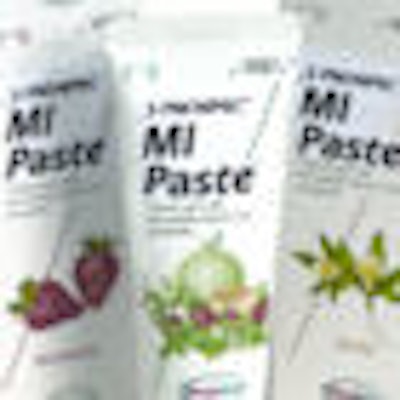
The research community has been divided over the effectiveness of calcium phosphate products in remineralizing teeth and reversing caries progression. But evidence supporting the use of amorphous calcium phosphate (ACP) systems continues to mount, with much of the research favoring casein phosphopeptide-amorphous calcium phosphate (CPP-ACP) and casein phosphopeptide-amorphous calcium fluoride phosphate (CPP-ACFP) products.
Recent years have seen a series of remineralization product launches, along with published papers debating the pros and cons of these products.
In mid-2008, at the International Association for Dental Research meeting, NovaMin Technology presented research indicating that its ReNew remineralizing and desensitizing paste -- a compound made from calcium, phosphorus, silica, and sodium -- is better than the established MI Paste -- which contains CPP-ACP, also known as Recaldent -- marketed by GC America.
A May 2008 study in Caries Research lent further support to these findings (Vol. 42:3, pp. 171-184). In that study, 2,720 students at 29 schools chewed either Trident White with CPP-ACP or a placebo gum for at least 10 minutes, three times a day for two years. Less than 1% of the subjects in both groups showed signs of caries after one year. But the investigators determined that, relative to the control gum, the Trident White gum resulted in 18% fewer lesions, which was a statistically significant difference.
A few months later, scientists from the University of Western Ontario combed the literature for randomized trials of products containing CPP-ACP and noted that only two of the 10 studies on caries prevention were conducted in people (Journal of the American Dental Association, July 2008, Vol. 139:7, pp. 915-924). The other eight were performed in laboratory settings, and six of the 10 studies were conducted by the product's inventor, University of Melbourne professor Eric Reynolds, PhD, and his collaborators. All six sided with CPP-ACP-containing products as being more efficacious than competitors. In contrast, all four of the studies conducted by independent investigators did not show a preponderance of evidence in favor of the CPP-ACP-containing products.
More recently, however, reviewers at the University of Valencia concluded that "use of CPP-ACP-based compounds offers a potential for use in the prevention of dental caries" (Journal of Contemporary Dental Practice, May 2009, Vol. 10:3, pp. 1-9). And yet just three months later, Domenick Zero, DDS, director of the Indiana University Oral Health Research Institute, wrote that "the clinical benefits of CPP-ACP in paste form with and without fluoride have not yet been substantiated by credible scientific evidence" (Advances in Dental Research, August 2009, Vol. 21:1, pp. 30-34).
Crystalline phases
Now a new study in the Journal of Dental Research -- also co-authored by Reynolds -- reviews the growing body of research on calcium phosphate systems in an effort to determine which demonstrate the most promise for non-invasive management of dental caries (JDR, November 2010, Vol. 89:11, pp. 1187-1197).
Calcium phosphate can exist in various crystalline phases, including brushite (dicalcium phosphate dehydrate), tricalcium phosphate (TCP), octacalcium phosphate, hydroxyapatite, and fluorapatite, according to the JDR study authors. A variation on the use of crystalline calcium phosphates is solid calcium sodium phosphosilicates, or bioactive glasses, such as found in NovaMin (GlaxoSmithKline).
Each has its pros and cons. In reviewing the research, Reynolds and his colleagues found that brushite, one of the more soluble crystalline calcium phosphate phases, was not effective in slowing caries progression when added to dentifrices to spur remineralization of enamel subsurface lesions (Journal of Clinical Dentistry, 1995, Vol. 6:3, pp.148-153).
And while TCP is touted by manufacturers as a white-spot lesion remineralizer, the JDR study authors found no published studies supporting this claim. Nor could they uncover studies supporting similar claims by the manufacturer of NovaMin.
ACP and ACFP
ACP and ACFP are unstabilized calcium and phosphate systems, which combine a calcium salt and a phosphate salt to produce an ion activity product, according to Reynolds and his co-authors.
In a clinical trial of ACP and ACFP toothpastes with individuals with a high caries risk, an ACFP-forming dentifrice proved to be more effective in lowering root caries than one that offered fluoride alone (Gerodontology, June 2008, Vol. 25:2, pp. 76-88). Neither dentifrice won out in regard to coronal caries increment, however.
The results were consistent when tested in a two-solution dental rinse (JDR, April 2000, Vol. 79:4, pp. 991-995). One solution containing both fluoride and phosphate ions and another with calcium ions combined just before use proved to be more effective at remineralizing enamel subsurface lesions than a fluoride-only rinse.
Even so, there are concerns about the benefits of unstabilized ACP/ACFP usage, Reynolds and his colleagues noted.
"Although some of these published papers suggest that the unstabilized ACP/ACFP technology may have efficacy in preventing caries progression, some authors have expressed concern with the unstabilized nature of the product that forms intraorally with this technology," they wrote. "The unstabilized ACP/ACFP may transform to poorly soluble phases in the mouth and, in so doing, may act to promote dental calculus."
CPP-ACP and CPP-ACFP
Stabilized ACP systems offer a positive alternative, according to the JDR study authors. Casein phosphopeptides, which are found in bovine milk, have demonstrated remineralization characteristics on enamel subsurface lesions. Research has shown that they also play a role in inhibiting crystal demineralization.
One study, a meta-analysis of data gathered from CPP-ACP and CPP-ACFP research, confirms this assertion (Acta Odontologica Scandinavica, January 2009, Vol. 67:6, pp. 321-332). Another double-blind study found that sugary confections containing CPP-ACP actually produced remineralization, while those without it led to demineralization (Caries Research, March 2010, Vol. 44:1, pp. 33-40).
Another randomized, double-blind, in situ study tested the response of plaque calcium and phosphate levels to four different rinses: water, 2% CPP-ACP, 6% CPP-ACP, and unstabilized calcium and phosphate ions (JDR, March 2003, Vol. 82:3, pp. 206-211). After five days, the double-blind study concluded that the CPP-ACP rinses produced a higher incorporation of calcium and phosphate ions than the others.
A key finding in another study was that lesions treated with CPP-ACP were more resistant to acid than those that had not been treated (Caries Research, August 2007, Vol. 41:5, pp. 377-383).
"There is now a large body of scientific evidence demonstrating that CPP-ACP and CPP-ACFP can promote the remineralization of enamel subsurface lesions," they wrote. (It is important to note that Reynolds co-authored 16 of the 91 studies cited in the JDR paper.)
Future treatments
Even so, Reynolds and his colleagues see "considerable room" for development of noninvasive enamel remineralization treatments and management of noncavitated caries lesions, such as the development of an effective pretreatment to increase the surface porosity of caries lesions without acid etching. They also recommend finding ways to improve biopeptides' ability to stabilize, deliver, and control remineralization.
"This approach, together with an effective lesion pretreatment method, should lead to the development of a superior peptide-stabilized calcium, phosphate, and fluoride remineralization system that will represent a major advance in the noninvasive clinical management of noncavitated caries lesions," they concluded.
Copyright © 2010 DrBicuspid.com



















